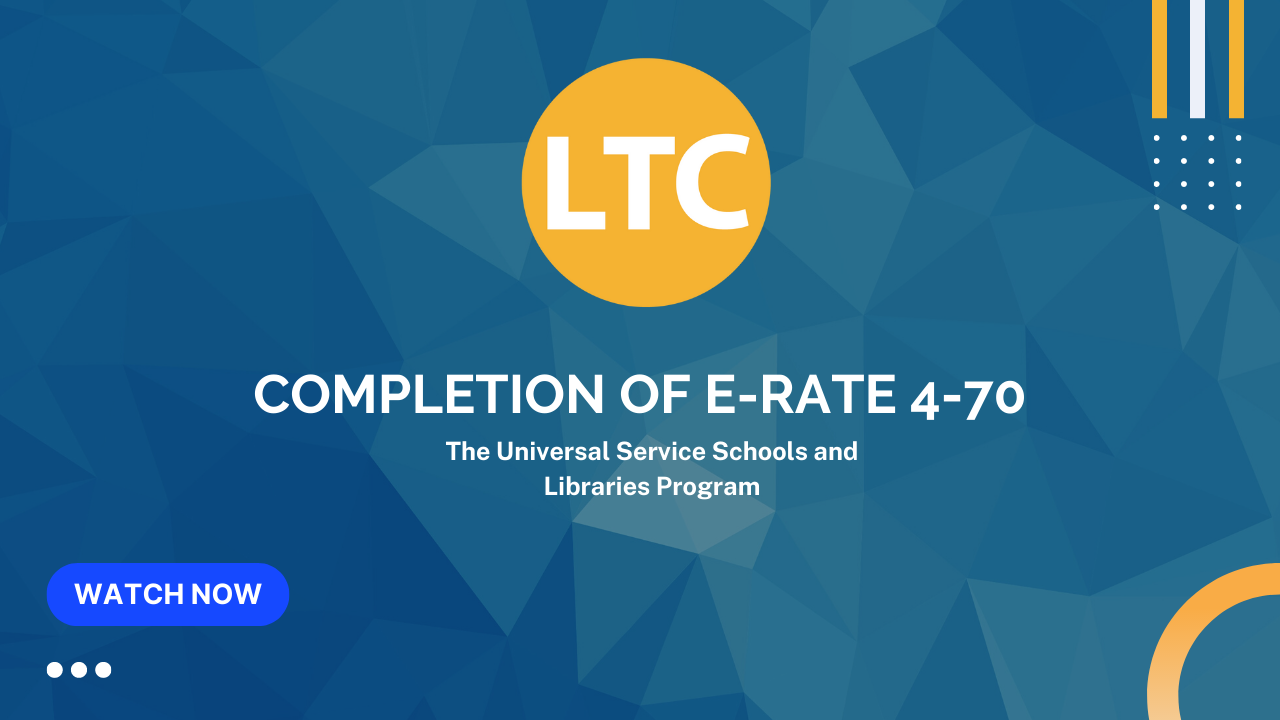E-Rate Consulting
Annual Funding for K-12 Connectivity and Technology Services
E-Rate (formally known as the Universal Service for Schools and Libraries Program) is a federal program designed to help schools and libraries afford internet and telecommunications services. Managed by the FCC, it offers discounts of 20% to 90% based on the institution’s economic need and location.
E-Rate aims to ensure equitable access to modern technology and information resources across all educational institutions. The program covers costs for internet access, internal networking, and telecommunications. Schools and libraries apply annually, following a competitive bidding process to ensure cost-effective spending.
Our Services
The Learning Technology Center provides complimentary E-Rate consulting to Illinois schools, offering:
- Application Support: Assistance in preparing and submitting E-Rate applications, including Form 470 and Form 471, to secure the funding your school needs.
- Compliance and Advocacy: Expert advice to ensure your projects comply with E-Rate rules and regulations.
- Training and Workshops: Educational sessions for your staff to demystify the E-Rate process and enhance your in-house capabilities.
While the LTC offers foundational E-Rate consulting, we recommend engaging a private consultant if comprehensive support is needed.
Benefits to Your District
- Maximize Funding: Ensure you’re not leaving any E-Rate dollars on the table.
- Streamlined Processes: Simplify the application and compliance processes with expert assistance.
- Empower Your Technology Goals: Use E-Rate funding to support your district’s technology upgrades and initiatives.
- Zero Cost: All consulting services are provided free of charge to school districts.
Resources and Common Questions
General Information
- E-Rate Overview (SETDA)
Illinois Resources
- Illinois E-Rate Consortium (ICN)
- Broadband Information (ISBE)
What does E-Rate Cover?
In recent years, the FCC refocused E-rate from legacy telecommunications services to broadband, with a goal to significantly expand Wi-Fi access. These steps to modernize the program are helping E-rate keep pace with the need for increased Internet access.
School districts can typically expect discounts on Category One (C1) services such as primary internet access, internet connections between buildings and construction required to obtain internet access. Category Two (C2) services include equipment and services used inside the school buildings to get internet access to student devices. Some of these items typically include routers, switches, and wireless access points. E-rate does NOT cover end user devices, such as computers or tablets. Each summer an Eligible Services list is posted for comment and then adopted by the program determining all items eligible for funding in that year.
How can I apply?
Districts who wish to apply for E-rate must follow an application process that includes multiple forms. The majority of this process is handled electronically within the E-rate Productivity Center (EPC). This dashboard provides access to the necessary forms and communications with Universal Service Administrative Company (USAC), who manages the process for the FCC. Individual forms walk applicants through a process of determining needed services, accepting bids, entering into contracts with providers and activation or completion of services. Districts begin the process of application up to a year before services are confirmed and implemented. This lengthy process containing multiple forms and timelines requires districts to oversee the applications and implementation of services over multiple years.
How big of a discount can your district receive?
E-rate discount levels are determined by district poverty level, primarily identified by eligibility in the National School Lunch Program (NSLP).
What state support is available?
Many state departments of education provide staff, or State E-rate Coordinators to help districts navigate the process. Melinda Fiscus, Digital Access Coordinator for the Learning Technology Center, serves as one of the State E-rate Coordinators for IL and provides support to school districts navigating the program and multiple forms. The LTC provides instruction, reminders, application workshops and general program guidance through ISBE support. Melinda also participates in national organizations that support the E-rate program such as the State E-rate Coordinators Association (SECA) and State Educational Technology Directors Association (SETDA) E-rate special interest group. Affiliation with these national organizations help insure Illinois Districts are kept up to speed with changes in the E-rate environment.
What is the Illinois E-Rate Matching Grant?
The Illinois State Board of Education (ISBE) has released a notice of funding opportunity/request for proposals (NOFO/RFP) for pending state funds to expand internet connectivity in schools. The funds would reimburse school districts for the cost of upgrading their broadband infrastructure to fiber optic technology. Fiber optic technology delivers the most affordable and fastest network speeds to schools and allows districts to scale cost-effectively to meet growing bandwidth needs in the future.
Nearly 75 districts across the state have been identified as having one or more school building in their district without access to this scalable infrastructure. Priority of funding will be given to districts that can demonstrate one or more buildings in their district is in need of a fiber upgrade.
In order to apply interested districts must:
- Leverage E-rate funding and apply for special construction on their E-rate 470 and 471 applications.
- Create a detailed RFP and/or Project. Guidance and sample templates are available from EducationSuperHighway, an Illinois Classroom Connectivity Initiative partner.
- Compare bids and choose a winning provider, following E-rate timelines, rules and guidance from USAC.
- Complete the IL E-rate State Matching Grant Form on the ISBE Broadband Information webpage.
The LTC provides approximately 30 in-person and online events each year to assist school districts with navigating the E-Rate process.
COMPLETION OF E-RATE 470
This video will demonstrate the completion of the E-rate 470 form. The E-rate 470 form opens the bidding process for the E-rate cycle each year.
ADDING CONTRACT TO E-RATE 471
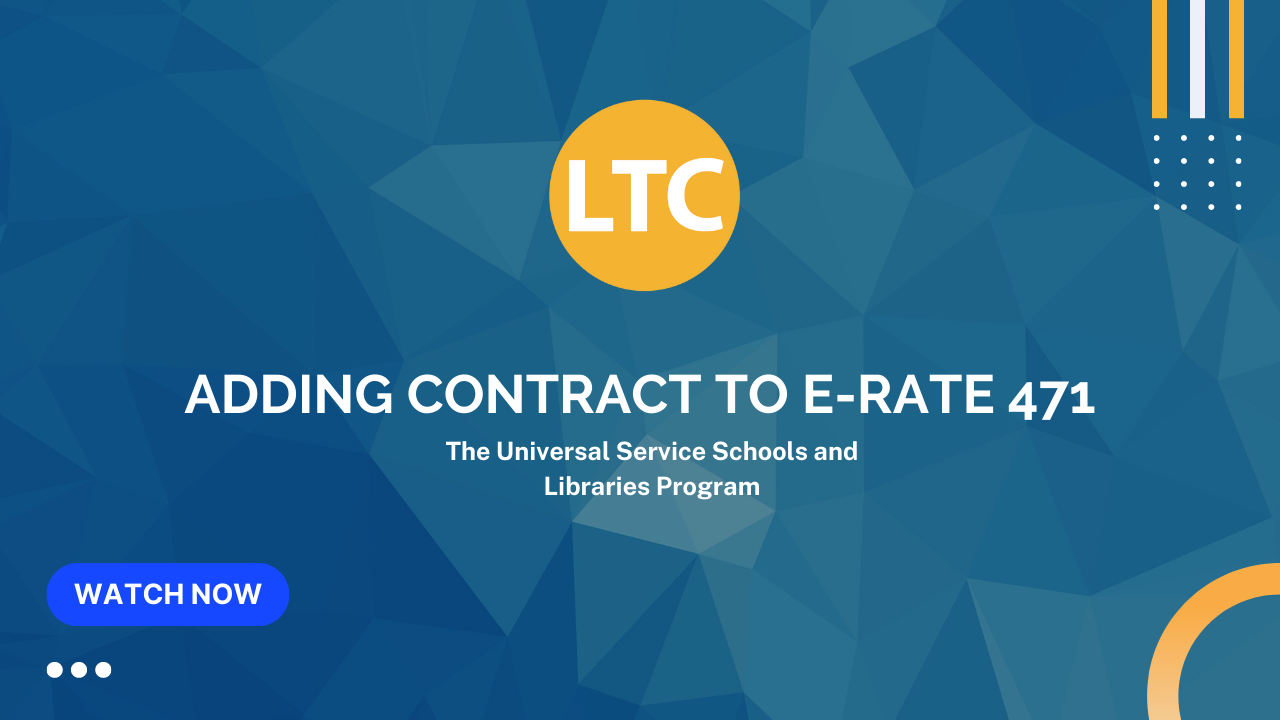
This video will demonstrate how to add a new contract to the E-rate EPC system for your Form 471. Contracts must be uploaded prior to completing the E-rate 471.
E-RATE 471 WALKTHROUGH
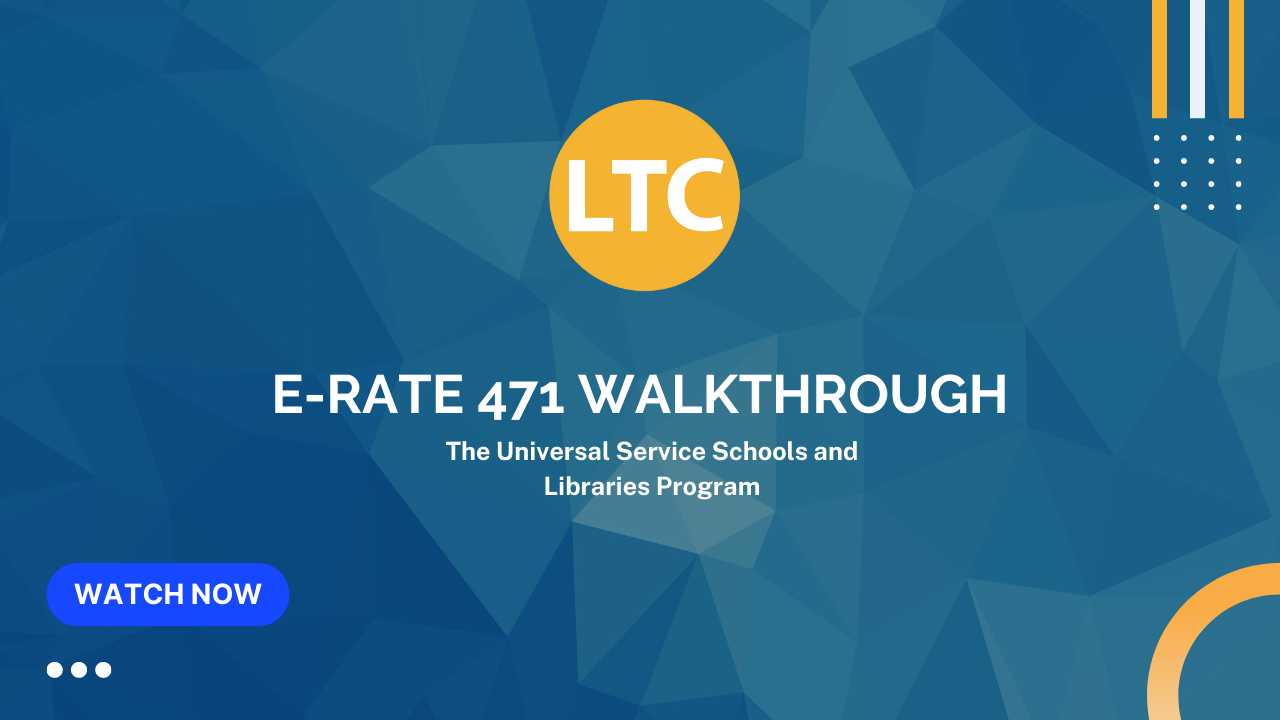


his video will demonstrate the completion of the E-rate 471 form, from the beginning, until choosing a category of service type. The E-rate 471 form commits to services for the E-rate cycle and is required each year. commits to services for the E-rate cycle and is required each year.
E-RATE 471 FUNDING REQUEST
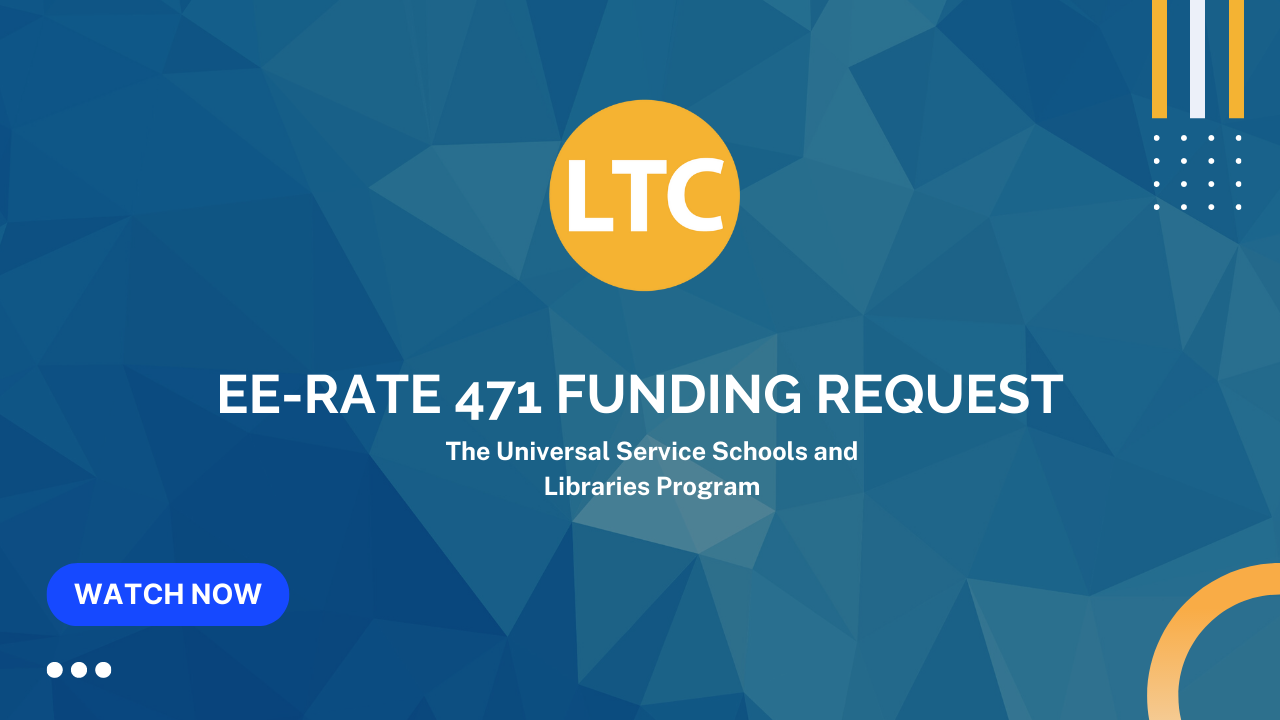


This video will demonstrate the completion of a funding request for special construction on the E-rate 471 form. The E-rate 471 form commits to services for the E-rate cycle and is required each year.
E-RATE 471 CAT 2 REQUEST
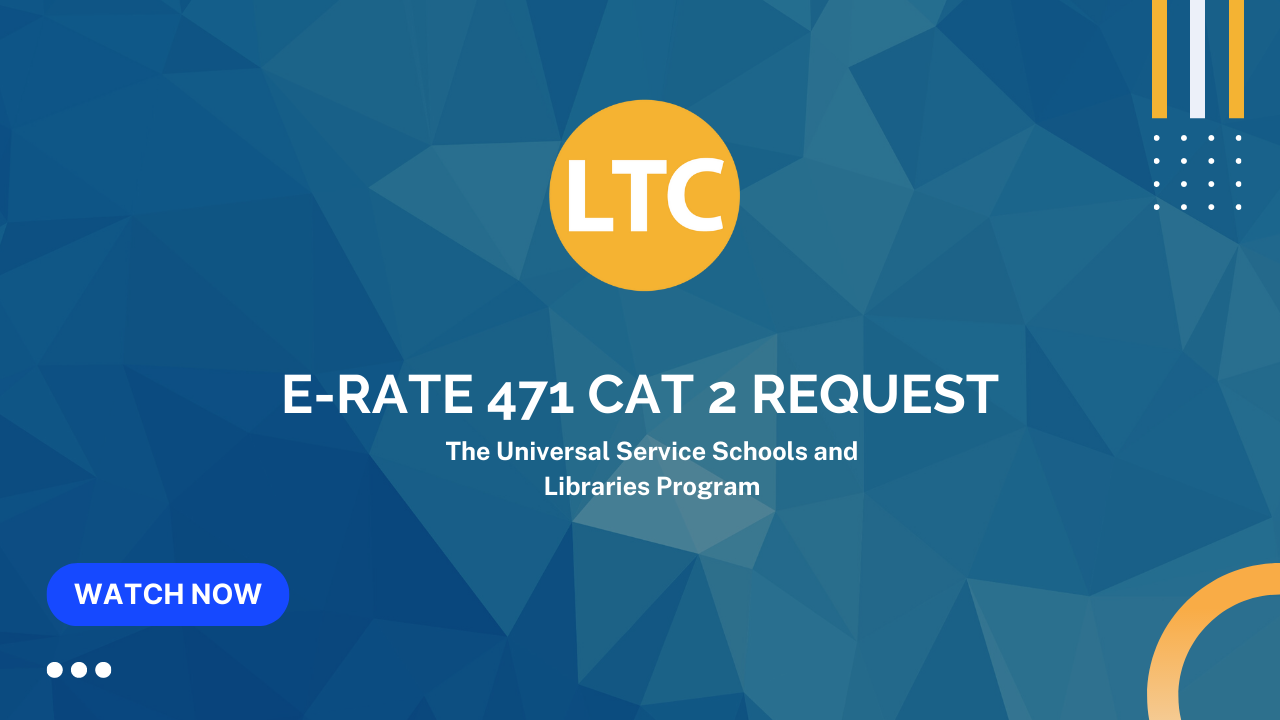


This video will demonstrate the completion of a funding request for category 2 services on the E-rate 471 form. The E-rate 471 form commits to services for the E-rate cycle and is required each year.
E-RATE 486 FORM UP TO CERT..



This video will demonstrate the completion of the E-rate 486 form up to the certification process.
E-RATE 486 FORM WITH CERTIFICATIONS



This video will demonstrate the completion of the E-rate 486 form up to the certification process.
General Information
- E-Rate Overview (SETDA)
Illinois Resources
- Illinois E-Rate Consortium (ICN)
- Broadband Information (ISBE)
What does E-Rate Cover?
In recent years, the FCC refocused E-rate from legacy telecommunications services to broadband, with a goal to significantly expand Wi-Fi access. These steps to modernize the program are helping E-rate keep pace with the need for increased Internet access.
School districts can typically expect discounts on Category One (C1) services such as primary internet access, internet connections between buildings and construction required to obtain internet access. Category Two (C2) services include equipment and services used inside the school buildings to get internet access to student devices. Some of these items typically include routers, switches, and wireless access points. E-rate does NOT cover end user devices, such as computers or tablets. Each summer an Eligible Services list is posted for comment and then adopted by the program determining all items eligible for funding in that year.
How can I apply?
Districts who wish to apply for E-rate must follow an application process that includes multiple forms. The majority of this process is handled electronically within the E-rate Productivity Center (EPC). This dashboard provides access to the necessary forms and communications with Universal Service Administrative Company (USAC), who manages the process for the FCC. Individual forms walk applicants through a process of determining needed services, accepting bids, entering into contracts with providers and activation or completion of services. Districts begin the process of application up to a year before services are confirmed and implemented. This lengthy process containing multiple forms and timelines requires districts to oversee the applications and implementation of services over multiple years.
How big of a discount can your district receive?
E-rate discount levels are determined by district poverty level, primarily identified by eligibility in the National School Lunch Program (NSLP).
What state support is available?
Many state departments of education provide staff, or State E-rate Coordinators to help districts navigate the process. Melinda Fiscus, Digital Access Coordinator for the Learning Technology Center, serves as one of the State E-rate Coordinators for IL and provides support to school districts navigating the program and multiple forms. The LTC provides instruction, reminders, application workshops and general program guidance through ISBE support. Melinda also participates in national organizations that support the E-rate program such as the State E-rate Coordinators Association (SECA) and State Educational Technology Directors Association (SETDA) E-rate special interest group. Affiliation with these national organizations help insure Illinois Districts are kept up to speed with changes in the E-rate environment.
What is the Illinois E-Rate Matching Grant?
The Illinois State Board of Education (ISBE) has released a notice of funding opportunity/request for proposals (NOFO/RFP) for pending state funds to expand internet connectivity in schools. The funds would reimburse school districts for the cost of upgrading their broadband infrastructure to fiber optic technology. Fiber optic technology delivers the most affordable and fastest network speeds to schools and allows districts to scale cost-effectively to meet growing bandwidth needs in the future.
Nearly 75 districts across the state have been identified as having one or more school building in their district without access to this scalable infrastructure. Priority of funding will be given to districts that can demonstrate one or more buildings in their district is in need of a fiber upgrade.
In order to apply interested districts must:
- Leverage E-rate funding and apply for special construction on their E-rate 470 and 471 applications.
- Create a detailed RFP and/or Project. Guidance and sample templates are available from EducationSuperHighway, an Illinois Classroom Connectivity Initiative partner.
- Compare bids and choose a winning provider, following E-rate timelines, rules and guidance from USAC.
- Complete the IL E-rate State Matching Grant Form on the ISBE Broadband Information webpage.
The LTC provides approximately 30 in-person and online events each year to assist school districts with navigating the E-Rate process.
COMPLETION OF E-RATE 470
This video will demonstrate the completion of the E-rate 470 form. The E-rate 470 form opens the bidding process for the E-rate cycle each year.
ADDING CONTRACT TO E-RATE 471



This video will demonstrate how to add a new contract to the E-rate EPC system for your Form 471. Contracts must be uploaded prior to completing the E-rate 471.
E-RATE 471 WALKTHROUGH



his video will demonstrate the completion of the E-rate 471 form, from the beginning, until choosing a category of service type. The E-rate 471 form commits to services for the E-rate cycle and is required each year. commits to services for the E-rate cycle and is required each year.
E-RATE 471 FUNDING REQUEST



This video will demonstrate the completion of a funding request for special construction on the E-rate 471 form. The E-rate 471 form commits to services for the E-rate cycle and is required each year.
E-RATE 471 CAT 2 REQUEST



This video will demonstrate the completion of a funding request for category 2 services on the E-rate 471 form. The E-rate 471 form commits to services for the E-rate cycle and is required each year.
E-RATE 486 FORM UP TO CERT..



This video will demonstrate the completion of the E-rate 486 form up to the certification process.
E-RATE 486 FORM WITH CERTIFICATIONS



This video will demonstrate the completion of the E-rate 486 form up to the certification process.


